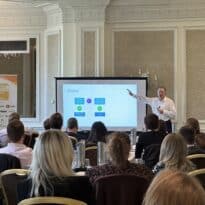Portfolio manager Talib Sheikh provides an update on recent positioning moves within Fidelity’s multi asset income range, highlighting the increased exposure to defensive quality income equities. He also shines a light on how the team are viewing and responding to the macro environment.
Why are interest rates higher today than they were a decade ago? The reality is that inflation has fallen, but it’s still much higher than it has been historically.
We believe we’re in a new regime where interest rates are higher, inflation is likely to be higher, and the coming months and years will require a more diversified approach to multi-asset income investing than the previous decade.
At the moment, interest rates look likely to fall over the coming years. We don’t expect them to go back to the zero-interest rate environment that we saw post the great financial crisis.
But we do think inflation is on the way down. Central banks including the Fed and the BoE have the opportunity to lower interest rates further from here.
Business cycles seem to have become more de-synchronised. If we think back to where we’ve been over the last year, the Chinese economy has been poor whereas the US economy has performed strongly. In addition, the European and UK economies have been lacklustre and that creates opportunities for asset allocators to try and find value in the disparity.
There are two broad components to inflation. The first is goods inflation, which depends on short-term inflation expectations and import prices. There was a big rise in goods inflation in the post-Covid opening, due to the disruption caused to supply chains. To some degree that has normalised, and it could be argued that this has helped drive headline inflation lower.
The other part is service inflation – how much people pay for goods and services that are much harder to trade across economies and across borders. That has been falling but remains sticky. When you look at the Bank of England (BoE) or the US Federal Reserve, it’s services inflation that they’re worried about, and it’s much harder to influence.
Closer to home, UK assets have been out of favour with global investors for a prolonged period. The FTSE 100 tends to have companies that are more internationally-focused and earn a relatively large proportion of their earnings overseas. However, UK small and mid-caps typically generate more income from within the UK. It is here that we believe there could be opportunities. In the UK the BoE is cutting interest rates, and we believe that they are showing they can get comfortable with the new government’s economic policy.
Portfolio positioning
In the equity space, our largest exposure remains in defensive quality income equities. There has been a lot said about technology, especially the “Magnificent Seven”, while many of the dividend-yielding stocks have relatively underperformed the market. We believe that’s about to change. The amount of dividends equity markets are paying at the moment is at an all-time high. We think that’s a pretty good set up for equity income and we are well positioned to benefit from any performance pick up.
Our tactical equity exposure is a balance between positions that will do well in different scenarios. We are finding opportunities within sectors such as financials, where banks have transformed since the great financial crisis. In many ways, regulators have turned them into quasi-utilities and have allowed them to return that capital to shareholders. We are also actively using overlays to hedge unwanted risks.
Within fixed income, we like to think about the available yield in two separate parts. The first part is the core interest rate, the interest rate that each government pays on their debt. Those have moved up since the great financial crisis, and we think there are some opportunities there.
The other part of the yield is what we call the spread, the premium received on top of government interest rates for lending to a corporate. These spreads are relatively tight at the moment. So, when we look at things like investment-grade credit, the higher-quality bonds, we would argue that the risk-reward isn’t great, meaning we’re relatively underweight.
When we look at more risky bonds such as high yield, we find that there are some more interesting opportunities. But we believe that they’re expensive and unlikely to give capital returns from here. The places that we find more interesting are some of the government bond marketsWe are beginning to feel more comfortable about duration because the equity-bond correlation has become less positive as central banks are no longer solely focused on inflation and are now considering growth implications as well. We expect duration to act more like a diversifier instead of something that will add to portfolio risk as has been the case over the previous few years. Therefore, we are looking to increase duration over the medium term, however, the timing will depend on the valuations.
We have some selective exposure to emerging market debt, but it’s on a country-specific basis. We are happy to be taking some more emerging market FX risk, because we think that the dollar has limited upside potential from here and could even depreciate thanks to the slowing US economy and the Fed starting its cutting cycle. The real yields available are attractive though, and we can envisage increasing that exposure over the next year or so.
Alternative income
The portfolio has had some exposure to several UK-listed investment trusts, particularly those associated with green power generation, which we think offer attractive cash flow and yields that are linked to inflation. They have had a rough ride this year, but we think that the worst is behind us.
We are also looking at things like structured credit. These are private credit markets where investors can get investment-grade quality exposure with attractive yields and very little interest-rate sensitivity.
First published on the Fidelity International website.
Important information
This information is for investment professionals only and should not be relied upon by private investors. Past performance is not a reliable indicator of future returns. Investors should note that the views expressed may no longer be current and may have already been acted upon. Fidelity’s Multi Asset Income funds can use financial derivative instruments for investment purposes, which may expose the fund to a higher degree of risk and can cause investments to experience larger than average price fluctuations. These funds take their annual management charge and expenses from your clients’ capital and not from the income generated by the fund. This means that any capital growth in the fund will be reduced by the charge. The capital may reduce over time if the fund’s growth does not compensate for it. The investment policy of these funds means they invest mainly in units in collective investment schemes. Changes in currency exchange rates may affect the value of investments in overseas markets. Investments in emerging markets can be more volatile than other more developed markets. The value of bonds is influenced by movements in interest rates and bond yields. If interest rates and so bond yields rise, bond prices tend to fall, and vice versa. The price of bonds with a longer lifetime until maturity is generally more sensitive to interest rate movements than those with a shorter lifetime to maturity. The risk of default is based on the issuers ability to make interest payments and to repay the loan at maturity. Default risk may therefore vary between government issuers as well as between different corporate issuers. Sub-investment grade bonds are considered riskier bonds. They have an increased risk of default which could affect both income and the capital value of the fund investing in them. Reference in this document to specific securities should not be interpreted as a recommendation to buy or sell these securities, but is included for the purposes of illustration only.
Main image: susan-wilkinson-aK6DIjf53nA-unsplash





































